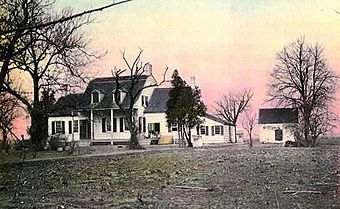Hendrick I. Lott House facts for kids
|
Hendrick I. Lott House
|
|
 |
|
| Location | 1940 East 36th Street, Brooklyn, New York |
|---|---|
| Built | 1720 |
| Architect | Hendrick I. Lott |
| Architectural style | Colonial |
| NRHP reference No. | 83004645 |
Quick facts for kids Significant dates |
|
| Added to NRHP | March 3, 1994 |
The Hendrick I. Lott House is a very old and important home in Marine Park, Brooklyn, New York City. It is located at 1940 East 36th Street. This house is one of the oldest Dutch Colonial homes in Brooklyn. It is listed on the National Register of Historic Places and is a New York City designated landmark. The house is still strong and looks much like it did when Hendrick Lott built it in 1800. He even used part of his grandfather Johannes Lott's original house from 1720.
History of the Lott House
Early Years: 1700s and 1800s
The Lott family's story in this area began in 1719. Johannes Lott, who was a leader in the New York Colonial Assembly, bought land in a farming area called Flatlands. He wanted to use this land for farming. Johannes made his family's land bigger, stretching from Kings Highway all the way to Jamaica Bay. He built his first home, called a homestead, near where the current house stands. Johannes passed away in 1775, and his son, Johannes Jr., took over the farm until 1792.
The Lott family became very important in the area. When Hendrick I. Lott married Mary Brownjohn in 1792, he felt his grandfather's house was too small. It was also old-fashioned for a well-known family like theirs. So, Hendrick built a new, larger, and more impressive house. He mixed Dutch architecture styles with English styles, creating a unique American building. Hendrick did not get rid of his grandfather's old house completely. He moved it to the eastern side of the new house, and it became the kitchen area. He then added a matching wing on the west side to make the house look balanced. The house has a special roof called a gambrel roof, which is common in Dutch colonial style. Inside, there are 18 rooms.
In the 1800s, the Lott farm was very large, covering more than 200 acres (0.8 square kilometers). Like many big farms in southern Kings County, the Lotts used the work of enslaved people. These enslaved people helped grow crops like cabbage, potatoes, and wheat. The Lotts sold these crops in markets in Brooklyn and Manhattan. They had more enslaved people than most of their neighbors.
In 1799, New York State began to make laws about freeing enslaved people. Male enslaved people born after July 4, 1799, would be freed at age 28. Females would be freed at age 25. These laws made it harder to keep enslaved people. Because of this, the Lotts freed almost all of their enslaved people by 1805. This was long before slavery was completely ended in New York State in 1827. After freeing them, the Lotts hired these people as paid workers. This suggests that the Lotts were against slavery, also known as abolitionists. People also believe that the Lott House might have been a safe place for people escaping slavery on the Underground Railroad.
By 1825, the 200-acre (0.8 square kilometer) farm had many buildings. These included barns and a separate stone kitchen. In 1998, archaeologists from Brooklyn College found the foundation of this old kitchen. It was located between the house and what is now East 36th Street.
The House Today
For 200 years, members of the Lott family lived in the house and farmed the land. The last family farmer, John Bennett Lott, passed away in 1923. Most of the farm land was sold, leaving only about three-quarters of an acre (0.3 hectares) around the house. The last Lott family member to live there was Ella Suydam. She was a great-great-great-great-granddaughter of Johannes Lott. She lived in the house until she passed away in 1989.
When researchers studied the house, they found rooms without windows. They thought these rooms might have been where enslaved people slept. Under the floors of these rooms, they found spiritual objects. These objects, like corncobs shaped like stars or crosses, showed that enslaved people had religious practices similar to those in West Africa. These objects were believed to connect the living world with the world of spirits.
Today, the Hendrick I. Lott House is still in its original spot on three-quarters of an acre (0.3 hectares) of land. The New York City Department of Parks & Recreation bought the house in 2001. The Hendrick I. Lott House Preservation Association now helps manage it. This group is also part of the Historic House Trust.
Work to fix the house's structure and roof began in the mid-2000s. The inside of the house was also restored. The restoration of the Lott House is a team effort. Many groups are involved, including the City of New York/Parks & Recreation, the Historic House Trust of New York City, the Marine Park Civic Association, and the Hendrick I. Lott House Preservation Association.
During the restoration, the house was sometimes open for visitors. People could see a "closet that is believed to have been a temporary haven for slaves escaping along the Underground Railroad." In February 2025, news reports said that the Lott House was being turned into a historic house museum. A company called Mitchell Giurgola was hired to help with the renovations. Structural repairs and interior restoration began in 2026.
See also





